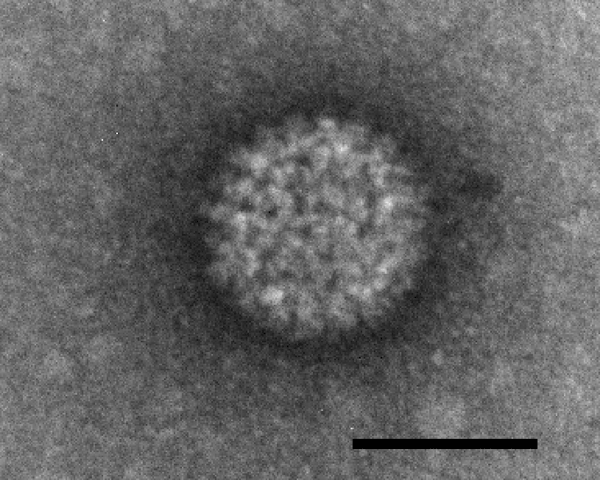The study of animal viruses is important from a veterinary viewpoint. Many animal viruses are also important from a human medical perspective . The emergence of the SARS virus in the human population, coming from an animal source, highlights the importance of animals in bearing infectious agents. Avian influenza viruses can directly infect humans. In addition research into animal viruses has made an important contribution to our understanding of viruses in general, their replication, molecular biology, evolution, and interaction with the host.

TEM of the Bluetongue virus
Bluetongue virus (BTV), a member of Orbivirus genus within the Reoviridae family causes serious disease in livestock (sheep, goat, cattle).
Rhabdoviruses are a diverse family of single stranded, negative sense RNA viruses that can successfully utilize a myriad of ecological niches, ranging from plants and insects, to fish and mammals. This virus family includes pathogens such as rabies virus, vesicular stomatitis virus, and potato yellow dwarf virus that are of tremendous public health, veterinary, and agricultural significance. Due to the relative simplicity of their genomes and morphology, in recent years rhabdoviruses have become powerful model systems for studying molecular virology.
Foot and mouth disease virus (FMDV) is the prototypic member of the Aphthovirus genus in the Picornaviridae family. This picornavirus is the etiological agent of an acute systemic vesicular disease that affects cattle worldwide, foot-and-mouth disease. FMDV is a highly variable and transmissible virus. It enters the body through inhalation. Soon after infection, the single stranded positive RNA that constitutes the viral genome is efficiently translated using a cap-independent mechanism driven by the internal ribosome entry site element (IRES). This process occurs concomitantly with the inhibition of cellular protein synthesis, caused by the expression of viral proteases. In depth knowledge of the molecular basis of the viral cycle is needed to control viral pathogenesis and disease spreading.
Pestiviruses account for important diseases in animals such as Classical swine fever (CSF) and Bovine viral diarrhea / Mucosal disease (BVD/MD). The molecular biology of pestiviruses shares many similarities and peculiarities with the human hepaciviruses. Genome organization and translation strategy are highly similar for the members of both genera. One hallmark of pestiviruses is their unique strategy to establish persistent infection during pregnancy.
Coronavirus (CoV) genome replication takes place in the cytoplasm in a membrane-protected microenvironment, and starts with the translation of the genome to produce the viral replicase.
The first line of defense against viral infections is usually antiviral vaccines, which prime the body's immune system against specific pathogens. Vaccines traditionally consist of an attenuated (weakened or killed) version of the virus, although many vaccines now target specific immunogenic targets unique to a particular pathogen. Both viral and cellular proteins are required for replication and transcription. CoVs initiate translation by cap-dependent and cap-independent mechanisms. Cell macromolecular synthesis may be controlled after CoV infection by locating some virus proteins in the host cell nucleus. Infection by different coronaviruses cause in the host alteration in the transcription and translation patterns, in the cell cycle, the cytoskeleton, apoptosis and coagulation pathways, inflammation, and immune and stress responses. The balance between genes up- and down-regulated could explain the pathogenesis caused by these viruses.
Antiviral drugs are a class of medication used specifically for treating viral infections. Like antibiotics for bacteria, antiviral drugs are usually specific for a particular virus. Unlike most antibiotics, antiviral drugs do not destroy their target pathogen; instead they inhibit their development.
In addition to targeting viral infections directly, some therapeutics work by enhancing the immune responses necessary for viral clearance. One of the best-known of this class of drugs are interferons, which inhibit viral synthesis in infected cells. Interferons (IFNs) play pivotal roles in shaping the immune responses in mammals and are particularly important for the control of viral infections, cell growth, and immune regulation. These proteins rapidly induce an "anti-viral state" in cells that surround infected cells. In order to survive, viruses have evolved multiple strategies to evade the anti-viral effects of IFNs. Elucidating the molecular and cellular biology of the virus-interferon interaction is key to understanding issues such as viral pathogenesis, latency, and the development of novel antivirals.
Pediatric polio vaccination in India by a Stop Transmission of Polio (STOP) teams (2002)
Vaccinations are the best defense against a wide range of viruses, but they are not effective in treating active infections.